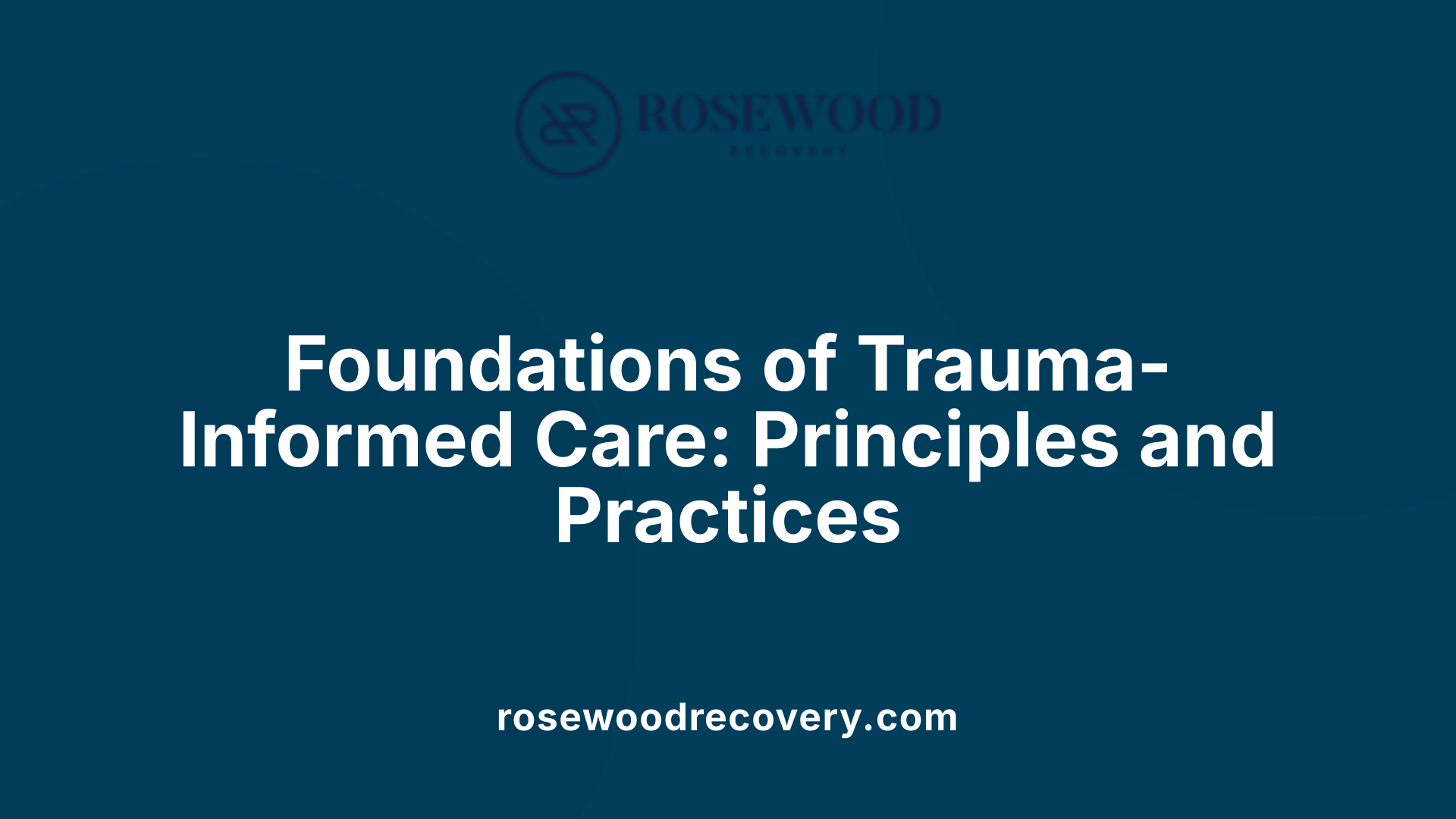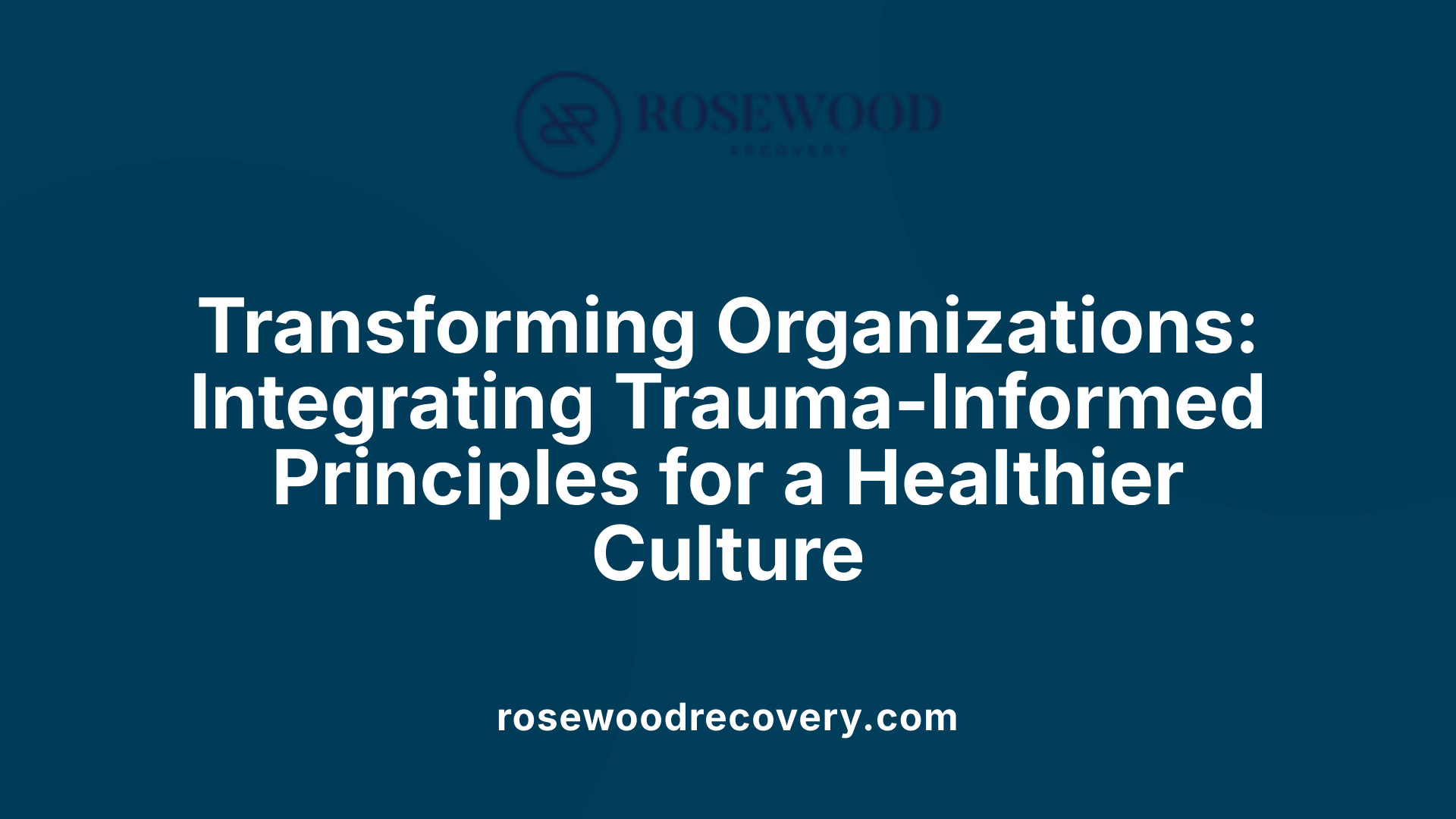Understanding the Intersection of Trauma and Addiction
Trauma-informed group therapy has emerged as a vital approach within the comprehensive treatment of substance abuse and mental health disorders. Recognizing the high prevalence of trauma among individuals with addiction, this therapeutic method fosters a safe, supportive environment that addresses the complex needs of trauma survivors. This article explores the significant benefits of trauma-informed group therapy and its integral role in enhancing treatment outcomes for addiction and co-occurring mental health issues.
Foundations of Comprehensive Treatment Services for Substance Abuse

What are the key components of comprehensive treatment services for substance abuse?
Comprehensive treatment for substance abuse integrates several crucial elements to address the complex needs of individuals. These services start with thorough clinical assessments to understand substance use patterns, trauma history, and co-occurring mental health issues. An individualized treatment plan is then developed, tailored to the person's unique strengths, challenges, and goals.
Key components include detoxification when necessary, evidence-based behavioral therapies such as cognitive-behavioral therapy (CBT), and medication management that helps control cravings and prevent relapse. Treatment is offered in various settings, including inpatient and outpatient programs, supporting continuous care throughout recovery.
Trauma-informed care (TIC) plays a vital role by recognizing the widespread impact of trauma and integrating practices that promote safety, trust, and empowerment. TIC helps reduce re-traumatization and enhances engagement and retention in treatment. Case management coordinates services and social supports to address broader needs.
How is individualized treatment planning applied?
Individualized plans consider trauma histories, mental health status, cultural background, and personal preferences. They incorporate goals for sobriety, emotional regulation, and resilience building. Treatment strategies often include trauma-informed group therapy and peer support, fostering validation and connection.
What is the role of multidisciplinary team involvement?
Multidisciplinary teams comprising medical professionals, mental health therapists, nurses, peer counselors, and social workers collaborate to provide holistic care. This team approach ensures integrated management of substance use, trauma symptoms, mental health disorders, and social challenges.
How does trauma-informed care enhance treatment?
TIC emphasizes creating safe and supportive environments, promoting client choice, and fostering collaborative relationships. It reframes trauma responses as adaptive, reducing stigma and promoting empowerment. Implementing TIC throughout treatment— from intake to therapy sessions— improves mental health outcomes and reduces risk of retraumatization, ultimately supporting lasting recovery.
Addressing Co-Occurring Mental Health Issues Through Integrated Treatment

How do treatment programs address co-occurring mental health issues along with addiction?
Treatment programs adopt integrated approaches that concurrently address both addiction and co-occurring mental health conditions such as depression, anxiety, and PTSD. This unified strategy allows providers to comprehensively assess and treat symptoms for improved recovery outcomes.
Integration of Mental Health and Addiction Treatment
These programs often blend evidence-based therapies including motivational enhancement and cognitive-behavioral therapy (CBT) with pharmacotherapy when necessary. Trauma-informed approaches play a critical role by recognizing the high prevalence of trauma history—up to 95%—among individuals with substance use disorders. By incorporating trauma-informed care, treatment can reduce retraumatization and better address underlying mental health challenges linked to trauma.
Trauma-Informed Group Therapies
Trauma-informed group therapies provide safe settings where clients share experiences and foster mutual support. These groups emphasize coping skills and resilience building rather than direct trauma processing, which helps prevent distress and promotes healing. Peer support within these groups enhances feelings of belonging and reduces isolation, crucial for long-term recovery.
Staff Training and Cultural Competence
Effective integration also depends on ongoing staff training focused on trauma-informed principles and cultural responsiveness. This prepares care teams to deliver empathetic, non-pathological, and strengths-based care sensitive to diverse clients' biopsychosocial and cultural backgrounds, improving engagement and trust.
Community Support and Mutual Help
Community-based mutual help groups form a vital extension of care, offering sustained peer support that reinforces therapeutic gains. These organizations facilitate ongoing empowerment and resilience by fostering connections beyond formal treatment settings.
Through this coordinated, trauma-informed, and culturally sensitive approach, integrated treatment programs effectively address the complex needs of individuals facing both addiction and mental health disorders, leading to improved symptom reduction, engagement, and sustained recovery.
The Prevalence and Impact of Trauma Among Individuals with Substance Use Disorders

How common is trauma among individuals with substance use disorders?
Trauma is highly prevalent among people with substance use disorders. Research suggests that up to 75% and in some studies even 95% of individuals struggling with substance use have a history of traumatic experiences. These events, which can be physically or emotionally harmful or threatening, often play a significant role in the onset and progression of addiction.
In what ways does trauma influence addiction and mental health?
Trauma impacts both addiction and mental health profoundly. It increases the risk of developing substance use disorders as well as co-occurring mental health issues like depression, anxiety, and PTSD. Trauma can affect engagement in treatment and recovery by influencing how individuals cope, highlighting the importance of trauma-informed care to prevent re-traumatization and support lasting recovery.
How do biopsychosocial and cultural factors affect individual trauma responses?
Responses to trauma are highly individualized and influenced by a combination of biological, psychological, social, and cultural factors. These elements shape how trauma affects one's emotional and physical well-being, resilience, and coping strategies. Recognizing cultural and systemic contexts is essential for designing effective, trauma-informed interventions that address unique backgrounds and experiences.
Core Principles and Practices of Trauma-Informed Care in Group Therapy Settings

What Are the Six Key Principles of Trauma-Informed Care?
Trauma-informed care (TIC) is grounded on six essential principles that guide effective treatment and interaction in therapeutic settings. These include:
- Safety: Ensuring physical and emotional safety for all participants.
- Trustworthiness and Transparency: Maintaining clear communication and consistency to build trust.
- Peer Support: Encouraging connections and shared experiences among clients to foster healing.
- Collaboration and Mutuality: Engaging both clients and providers as partners in care.
- Empowerment, Voice, and Choice: Supporting client autonomy and decision-making.
- Cultural, Historical, and Gender Issues: Recognizing and respecting each individual’s unique background and experiences.
These principles foster a foundation where trauma survivors feel respected and supported.
How Is a Safe and Empowering Environment Created?
In trauma-informed group therapy, creating an environment that diminishes fear and promotes trust is vital. This is achieved by:
- Establishing clear group norms and confidentiality agreements.
- Using calming techniques and flexible scheduling to accommodate trauma symptoms.
- Offering consistent reassurance and non-judgmental support.
- Encouraging resilience-building by emphasizing client strengths rather than pathology.
This environment reduces the risk of re-traumatization and promotes emotional healing.
How Does Trauma-Informed Care Support Client Choice and Collaboration?
TIC prioritizes client agency through offering choices at every stage of treatment. This includes:
- Allowing clients to decide their level of participation and what topics they share.
- Engaging clients in developing treatment goals and planning.
- Foster collaboration between clients and therapists to create trust and mutual respect.
Such practices empower individuals and strengthen their commitment to recovery.
How Is Re-Traumatization Prevented?
Preventing re-traumatization is a core objective of TIC. Strategies include:
- Avoiding triggering language and insensitive practices like seclusion or restraint.
- Providing psychoeducation about trauma reactions to normalize experiences.
- Recognizing trauma symptoms as adaptive responses rather than pathologies.
- Incorporating trauma-sensitive therapeutic modalities such as Seeking Safety and cognitive-behavioral techniques.
Together, these practices reduce harm and support sustainable recovery.
Trauma-Informed Group Therapy: Creating a Safe Space for Healing and Connection

What Makes Trauma-Informed Group Therapy a Safe Environment?
Trauma-informed group therapy prioritizes creating a safe and supportive environment for survivors of trauma. This safe space reduces fear and anxiety, allowing participants to feel comfortable sharing their experiences without judgment or intimidation. Safety is essential because trauma survivors often carry heightened sensitivity to triggers and may have difficulty trusting others.
How Does Sharing Stories Provide Emotional Validation?
In trauma-informed group therapy, sharing personal stories is encouraged as a way to foster emotional validation. When individuals share their experiences, they receive acknowledgment and empathy from others who understand similar struggles. This validation helps reduce feelings of shame, guilt, or isolation that often accompany trauma.
What Are the Benefits of Peer Support?
Peer support is a vital component of trauma-informed group therapy. It offers participants a sense of belonging and mutual understanding. Through sharing coping strategies and encouraging each other, group members can build resilience together. Peer support also helps reduce feelings of loneliness and reinforces that individuals are not alone in their recovery journeys.
How Does Group Therapy Reduce Isolation and Encourage Belonging?
Trauma survivors frequently experience social isolation due to stigma or withdrawal. Group therapy combats this by fostering connections among members. The shared experiences promote trust and create strong bonds, helping participants feel accepted and supported. This sense of belonging is crucial in maintaining ongoing motivation and hope throughout recovery.
Together, these elements make trauma-informed group therapy a powerful approach for healing, connection, and long-term resilience.
Therapeutic Modalities and Advancements Within Trauma-Informed Group Therapy
What are the trauma-focused psychotherapy techniques used in group therapy?
Trauma-informed group therapy often incorporates evidence-based trauma-focused psychotherapy techniques such as Cognitive Behavioral Therapy (CBT), Trauma-Focused CBT (TF-CBT), Eye Movement Desensitization and Reprocessing (EMDR), exposure therapy, and psychodrama therapy. These modalities foster safe emotional expression, reduce trauma symptoms like PTSD, anxiety, and depression, and promote healing through shared group experiences.
How do mindfulness and expressive arts contribute to trauma-informed group therapy?
Recent advancements in trauma treatment include mindfulness practices and expressive arts therapies, such as art, music, and movement, within group settings. These approaches help participants enhance emotional regulation, promote relaxation, and foster resilience in a non-verbal, creative, and supportive environment. Such modalities augment traditional therapies by addressing trauma’s cognitive, emotional, and physical effects simultaneously.
What role does telehealth and integrated holistic approaches play?
The expansion of telehealth has increased accessibility to trauma-informed group therapy, allowing clients to engage safely and comfortably from diverse locations. Additionally, integrated holistic approaches combining physical, emotional, and social care—such as yoga, nutrition, and peer support—are being combined with psychotherapy to address trauma’s multifaceted impacts comprehensively.
How is personalized evidence-based care integrated?
Personalized trauma-informed care tailors interventions to individual needs, trauma histories, and cultural backgrounds. Treatment plans in group therapy incorporate client feedback, symptom monitoring, and engagement levels to adapt strategies effectively. This approach respects diversity and ensures tailored healing journeys that maximize therapeutic effectiveness and long-term recovery.
Enhancing Treatment Engagement and Outcomes Through Trauma-Informed Approaches
How Does Trauma-Informed Care Improve Client Engagement?
Trauma-informed care (TIC) recognizes that trauma affects up to 95% of individuals seeking substance use and mental health treatment. By understanding trauma's widespread impact, TIC creates environments that prioritize safety, trust, and collaboration. This supportive atmosphere helps clients feel more comfortable and willing to participate, thereby increasing engagement in treatment. The approach tailors care to acknowledge trauma symptoms, reducing fear and resistance.
In What Ways Does TIC Reduce Stigma and Barriers to Treatment?
Traditional treatments may unintentionally stigmatize or trigger clients with trauma histories. TIC shifts the focus from "What’s wrong with you?" to "What happened to you?" This perspective removes blame and fosters empathy. By emphasizing client choice and culturally responsive practices, TIC addresses barriers like mistrust or fear of re-traumatization. Organizational integration of trauma-aware policies further enhances access and reduces dropout rates.
How Does Addressing Trauma Symptoms Prevent Re-Traumatization?
Trauma responses are adaptive behaviors that may surface during treatment. TIC providers use non-triggering language and create environments that avoid practices like seclusion or restraint, which can cause harm. Routine trauma screening and stability-focused strategies help detect and accommodate symptoms like heightened startle responses or anxiety. This prevents re-traumatization, supports emotional regulation, and promotes resilience.
How Does TIC Foster Client Empowerment and Hope?
Central to TIC is recognizing client strengths and fostering empowerment. By involving clients in decision-making and treatment planning, TIC rebuilds trust and promotes autonomy. The integration of peer support and trauma-informed group therapy strengthens social connections and reduces isolation. TIC also emphasizes hope and recovery beyond symptom management, leading to improved mental health and substance use outcomes.
The Influence of Trauma-Informed Group Therapy on Staff Well-Being and Organizational Culture

Staff Education and Preparedness
Implementing trauma-informed care (TIC) involves comprehensive staff education to ensure personnel understand trauma's impact and are equipped to integrate trauma-informed principles in their work. Training cultivates high levels of staff self-efficacy and readiness, as reported in residential treatment centers where trauma-informed group therapy was successfully delivered. This education empowers staff to create safe, empathetic environments that recognize and respond to trauma without retraumatization.
Supporting Staff Professional Quality of Life
Staff engaged in trauma-informed group therapy programs often report high professional quality of life. The supportive framework of TIC, which emphasizes empathy and avoiding retraumatization, fosters positive work experiences. Maintaining such an environment helps staff stay motivated and connected to the mission of fostering recovery and resilience for clients.
Reducing Provider Burnout and Turnover
By embedding trauma-informed principles into practice, organizations reduce stressors linked to provider burnout and turnover. TIC fosters healthier work cultures with values-aligned hiring, staff wellness support, and safe spaces—both physical and emotional. These factors collectively contribute to sustained staff well-being, lower burnout rates, and improved retention, essential for continuity of care.
Organizational Changes to Embed Trauma-Informed Care
Embedding TIC requires systemic changes at the organizational level, including revising policies, implementing trauma screening protocols, and promoting collaborative care models. Organizations commit to ongoing staff training and cultural shifts that prioritize safety, trustworthiness, and empowerment. These transformations create resilient care environments that support both clients and staff comprehensively.
Personalizing Addiction and Mental Health Treatment Within Trauma-Informed Frameworks

Why is a personalized approach important in treating addiction and mental health issues?
Personalized treatment is essential because every individual's experience with addiction and mental health is unique, shaped by their trauma history, biology, and cultural background. Trauma-informed care recognizes that effective treatment cannot be one-size-fits-all; instead, it tailors interventions to address each person's specific needs. This approach enhances treatment engagement, motivation, and long-term recovery success.
Biological and cultural factors in treatment planning
Understanding biological differences—such as neurocognitive function and genetic biomarkers—allows clinicians to select targeted pharmacological and psychological therapies. These neurocognitive insights help explain how trauma impacts brain functioning and behavior, guiding clinicians in designing strategies that optimize healing.
Cultural context also plays a critical role. Trauma responses, coping styles, and treatment preferences vary across cultures, so incorporating cultural competence ensures that care respects and aligns with the client’s values and community practices.
Adaptive treatment plans
A trauma-informed framework supports developing flexible, adaptive treatment plans that evolve as clients progress. By continuously assessing trauma impact and recovery stages, providers can adjust therapeutic options, co-occurring disorder management, and support services. This responsive method reduces relapse risk and addresses the complex interplay between trauma, addiction, and mental health.
Neurocognitive insights guiding therapy
Advancements in neuroscience reveal how trauma affects cognition, emotion regulation, and stress responses. Integrating these insights into treatment allows the use of modalities such as trauma-focused cognitive behavioral therapy and mindfulness. These therapies enhance emotional regulation, improve coping skills, and foster resilience, essential for sustained recovery within trauma-informed care.
| Aspect | Description | Impact on Treatment |
|---|---|---|
| Personalized Approach | Tailoring interventions based on individual trauma history, biology, and culture | Improved engagement, reduced relapse risk |
| Biological Factors | Neurocognitive function and biomarkers guide therapy selection | Targeted interventions, enhanced efficacy |
| Cultural Considerations | Incorporation of client’s cultural background and values | Culturally sensitive, respectful care |
| Adaptive Treatment Plans | Evolving treatment based on ongoing client assessment | Greater flexibility, sustained recovery |
| Neurocognitive Insights | Understanding trauma’s effect on brain and behavior | Integration of specialized therapies |
This personalized, trauma-informed framework advances addiction and mental health treatment by addressing the complex, multifaceted nature of trauma and recovery, making care more effective and empowering for clients.
Measuring Success and Sustaining Recovery in Trauma-Informed Group Therapy
How is participant feedback and progress tracking utilized in trauma-informed group therapy?
Participant feedback is a crucial success metric in trauma-informed group therapy, enabling therapists to tailor treatment to individual needs and enhance therapeutic effectiveness. Progress tracking regularly monitors symptom improvement and coping skill development, ensuring that therapy remains responsive to client needs.
What role do engagement and symptom recurrence metrics play in assessment?
Engagement levels indicate the degree to which clients participate actively in therapy sessions, a predictor of positive outcomes. Monitoring symptom recurrence helps therapists identify challenges early and adjust interventions to prevent setbacks, supporting sustained recovery.
How do long-term resilience and community connection feature in the recovery process?
Trauma-informed group therapy fosters resilience by building emotional regulation, personal strength, and adaptive coping mechanisms. Additionally, group dynamics enhance community connection, reducing isolation and promoting sustained support networks critical for long-term recovery.
What is the role of trauma-informed care in comprehensive treatment?
Trauma-informed care integrates principles such as safety, empowerment, and trust across all treatment stages. It supports holistic healing by acknowledging trauma's impact on mental health and substance use, improving engagement, preventing retraumatization, and encouraging lasting recovery within supportive community environments.
Long-Term Benefits of Trauma-Informed Group Therapy in Addiction and Mental Health Treatment
Trauma-informed group therapy stands as a transformative element in comprehensive treatment for addiction and co-occurring mental health disorders. By centering safety, trust, and empowerment, it fosters healing, reduces retraumatization, and enhances client engagement. This approach not only improves individual outcomes but also supports staff well-being and promotes organizational culture change. Its integration with personalized care plans and evidence-based therapies ensures treatment relevance and resilience building, contributing to lasting recovery and healthier communities worldwide.
References
- Trauma-Informed Care: A Sociocultural Perspective
- Feasibility and outcomes of a trauma-informed model ...
- The Importance of Trauma-Informed Care in Addiction ...
- 10 Benefits of Trauma Informed Care for Adults in Recovery
- The Power Of Trauma Informed Group Therapy In Recovery
- Trauma-Informed Approaches and Programs
- Trauma-Informed Therapy - StatPearls
- Trauma-Informed Care for Substance Abuse Counseling



.jpeg)
